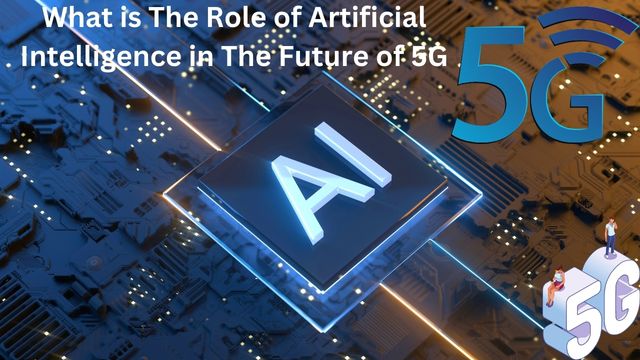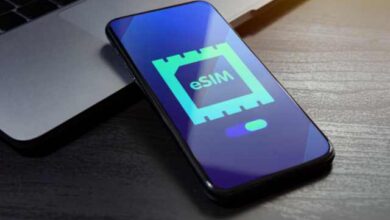What is The Role of Artificial Intelligence in The Future of 5G

Mobile communications service providers are facing new issues with the introduction of 5G, and one solution used by the sector to handle these complications is the integration and role of artificial intelligence (AI) capabilities into networks.
132 service providers from around the world were surveyed by Ericsson regarding their present and future plans for integrating AI into their networks.
This paper looks at how far service providers have already taken AI implementation, the experiences and difficulties they have had, and their future deployment plans.
Table of content
- What is Artificial Intelligence?
- What is 5G?
- What is The Role of Artificial Intelligence in The Future of 5G
- Why is 5G Relevant to the Field of AI?
- How Does 5G Help AI?
- How Machine Learning is Impacting 5G Wireless Technology?
- Top 5G Innovations on the Horizon
- Conclusion
What is artificial intelligence?
The simulation of human intelligence processes by machines, typically computer systems, is known as artificial intelligence (AI).
The three primary cognitive abilities that AI algorithms concentrate on are learning (acquiring data and developing rules for sorting that data), reasoning (selecting the appropriate data to produce the intended outcome), and self-correction (fine-tuning the data sorting for the most accurate results).
Algorithms are the terminology for the data sorting rules, which provide detailed instructions on how to accomplish a goal.
What is 5G?
All US cellular operators have now introduced 5G in some capacity. Describe 5G. The abbreviation 5G simply means fifth-generation cellular communication. Late 2017 saw the initial setting of its criteria. Low-band, mid-band, and high-band are the three fundamental forms of 5G service.
They all function differently and are currently incompatible with one another. Even while all US carriers “have” 5G at the moment, it will be a few more years before we notice any real changes.
In contrast, 4G was just introduced in 2010, and key apps that needed 4G to function did not become widely used until 2012 or 2013.
Ericsson, a significant supplier of information and communication technology (ICT) for service providers, projects that by 2024, 5G will have connected 40% of the world’s population.
Simply put, the “G” in 5G stands for “generation.” 1G was analogue mobile technology. The initial generation of digital cellular technologies was known as 2G. Speeds increased from 200 kbps to several megabits per second, thanks to 3G technologies.
Currently, 4G technologies provide hundreds of Mbps and even gigabit-level speeds. Bigger channels for faster speeds, lower latency for better responsiveness, and the capacity to connect more devices simultaneously are just a few of the additional features that 5G offers.

What is The Role of Artificial Intelligence in The Future of 5G
Adopting 5G networks entails a number of challenges, and the industry is tackling those challenges by incorporating artificial intelligence into networks. Over 50% of the decision-makers surveyed by Ericsson from 132 cellular firms around the world said they anticipated integrating AI into their 5G networks by the end of 2020.
Reducing capital costs, improving network performance, and creating new revenue streams are the main goals of AI integration. By enhancing network quality and providing personalized services, 55% of decision-makers claimed that AI is already being utilized to improve customer service and enhance the customer experience.
70% think that the best way to recover the costs associated with transitioning networks to 5G is to use AI in network design. Network performance management will be the primary focus of 64% of survey respondents’ AI efforts. Managing SLAs, product life cycles, networks, and revenue are further areas where cellular decision-makers plan to concentrate AI expenditures.
Of course, integrating AI into 5G networks is not without its difficulties. It is necessary to create efficient systems for gathering, organizing, and evaluating the massive amounts of data that AI generates. For this reason, once 5G networks become connected, early adopters of AI who are able to overcome these obstacles will unquestionably become the leaders.
Why is 5G relevant to the field of AI?
Although the underlying algorithms that power our smartphones have shrunk, they have not changed since the 1990s. As a result, 5G systems use far more power than ideal and deliver lower data rates than anticipated.
Deep learning AI will significantly reduce battery consumption and boost performance by replacing conventional wireless methods. This strategy will be more important overall than concentrating AI mainly on network management and scheduling.
Our cell phones’ core algorithms have gotten smaller, but they haven’t evolved since the 1990s. Thus, 5G systems require significantly more power than is desirable and provide lower data rates than expected.
By replacing current wireless technologies with deep learning AI, battery consumption will be greatly reduced and performance will be increased. Overall, this tactic will be more significant than focusing AI primarily on network management and scheduling.
5G delivers more than just better speeds, even though it can be up to 20 times faster than 4G. Due to its low latency, 5G speeds will enable programmers to make use of quicker response times by developing applications that include near real-time video transmission for security or sporting events.
Additionally, increased access to real-time data from multiple solutions will be possible thanks to 5G connectivity. Internet of Things (IoT) sensors are used by 5G since they are long-lasting and use a lot less electricity to operate.
This would make it possible to detect changes in factory equipment conditions and irrigation levels remotely. Patient data might be more simply and securely accessed by doctors. For each of these opportunities to be useful, AI will be used.
How Does 5G Help AI?
The idea behind edge computing is to process and analyze data on servers that are closer to the applications they support.
Many have stated that the introduction of “connected” devices, such as coffee cups and pill dispensers, did not cause the market to soar as projected, despite the fact that it is becoming more and more popular and providing new opportunities for telecom providers among other businesses.
However, by fusing big data, IoT, and AI, recent advances in technology have started to transform sectors and the amount of value that all these connections can offer consumers.
This transformation is accelerated by 5G since AI processing is easily supported by the 5G network design. The future of artificial intelligence will shift as a result of the 5G network architecture.
While AI will enable computers and systems to operate at levels of intelligence comparable to humans, 5G will improve the speed and integration of other technologies. In essence, 5G accelerates cloud services while AI processes and learns from the same data more quickly.
How Machine Learning is Impacting 5G Wireless Technology
What is Machine Learning?
Machine learning (ML) is a branch of artificial intelligence that, instead of utilizing explicit instructions, builds algorithms and statistical models to carry out specified tasks.
Without being particularly coded for that goal, ML algorithms create mathematical models from training data, which are samples of data. When compared to the fragile and manually constructed systems of today, learned signal processing algorithms can enable the next generation of wireless systems with notable power consumption reductions and gains in density, throughput, and accuracy.
How Can We Leverage Machine Learning and AI for 5G?
Without AI, a 5G network cannot be fully functional or effective. The utilization of 5G networks can be used to integrate ML and AI into the network edge. Multiple IoT devices can be connected at once utilizing 5G, creating enormous volumes of data that need to be analyzed using ML and AI.
Wireless service providers can provide the following when ML and AI are combined with 5G multi-access edge computing (MEC):
- High levels of automation from the network edge’s distributed ML and AI architecture
- Traffic steering across access networks based on applications
- To handle various scenarios with various quality of service (QoS) needs, dynamic network slicing
Why is Machine Learning Important for 5G Wireless Systems?
Current 4G networks transmit through Internet Protocol (IP) broadband connectivity, which is inefficient. In order for 5G networks to function, they must be proactive and predictive thanks to ML and AI.
Mobile devices will be able to build dynamically adaptable clusters based on learned data, and intelligent base stations will be able to make decisions for themselves thanks to the integration of ML into 5G technology. The effectiveness, latency, and dependability of network applications will all improve as a result.
Potentials and Limitations of Machine Learning for 5G Communications
ML will become increasingly important in realizing the 5G goal as the network gets more sophisticated and novel applications like driverless vehicles, industrial automation, virtual reality, e-health, and others arise. There are enormous potentials to be realized and obstacles to be surmounted, just like with any new technology.
Potentials of ML for 5G communications include
- A consistent coverage area is made possible by enhanced mobile broadband (eMBB), which enables new applications with higher data rate requirements. Virtual reality and streaming of ultra-high-definition video are two examples.
- Massive machine-type communications (mMTC): A significant feature of 5G communication services is the necessity for scalable connection to support an increase in the number of wireless devices while ensuring the effective transfer of modest amounts of data over broad coverage areas. This kind of traffic will be produced by applications like body-area networks, smart homes, IoT, and drone delivery. mMTC must be able to accommodate brand-new, unanticipated usage.
- Ultra-reliable low-latency communications (URLLC): Reliability, low latency, and mobility will take precedence over data rates in connected healthcare, remote surgery, mission-critical applications, autonomous driving, vehicle-to-vehicle (V2V) communications, high-speed train connectivity, and smart industry applications.
Limitations of ML for 5G communications include
- Data: High-quality data is required for machine learning applications, and the choice of whether to use labeled or unlabeled data depends on this choice. The quality of ML depends on the data it is fed.
- The no-free-lunch principle According to this theorem, if all potential data-generated distributions are averaged, every ML algorithm will perform equally well when attempting to infer unseen data. As a result, the objective of ML is to identify what type of distribution is relevant to a given 5G application and which ML algorithm has the best performance on that particular data, rather than to seek for the best learning algorithm possible.
- Selection of the hyperparameters: Before training, the ML algorithms’ hyperparameters are given values. Because they affect the ultimate parameters that are updated from the learning outcomes, these values need to be carefully chosen.
- Interpretability vs. accuracy: The intricate relationships between independent variables can be challenging for stakeholders to grasp and may not always be profitable. As a result, there must be a trade-off between total accuracy and data interpretation.
- Privacy and security: ML algorithms may be the target of adversarial attacks, such as changing an input sample to make a model classify it in a category other than its true class.
Top 5G Innovations on the Horizon
Industries are already attempting to innovate with 5G because of the potential for ML and AI to operate with 5G networks. Top breakthroughs that are soon to come include:
- Sports fans will be able to watch live games in 3D and from a variety of perspectives thanks to 5G technology.
- Wireless virtual reality (VR): 5G will enable consumers to access VR material at any time, anywhere.
- 5G will offer realistic augmented reality (AR) services, such as virtual zoos.
- Live performances: Wireless devices will be able to deliver incredibly high-quality live performances thanks to 5G.
- Game streaming: Games will be streamed while permitting user input over 5G and processed in the cloud.
- Online singalongs: Thanks to 5G technology, many people will be able to sing along together online.
- Self-driving cars: As real-time traffic updates, 3D city maps, and software updates are pushed through to vehicles, this technology will need computing capacity that can only be attained through 5G networks and AI.
- Wireless home: A few of the first 5G gadgets will provide indoor wireless hotspots.
- Low-power scanners are found in remote-control heavy machinery, ATMs, and some types of farm machinery These devices can operate for ten years on a single battery and yet periodically provide data because they don’t require a continual connection. Specialized technicians will be able to operate equipment from any location in the world.
- Infrastructure and public safety: Using 5G networks, cities, and other municipalities will be able to run more smoothly. Utility providers will be able to monitor usage remotely, public works departments will receive alerts when streetlights fail or drains flood and local governments will be able to swiftly and affordably install security cameras.
- Healthcare: There are prospects for telemedicine, remote recovery, augmented reality physical therapy, precision surgery, and even remote surgery. Insurers will be able to monitor subscribers to decide on the most effective treatments and procedures, hospitals will be able to build sensor networks to monitor patients, and doctors will be able to administer smart tablets to assess compliance.
- Future Of Artificial Intelligence: Truly Intelligences
- Best Programming Language for Artificial Intelligence
Conclusion
According to Ericsson, artificial intelligence (AI) is playing a bigger part in mobile networks. The research division of the Swedish company, Ericsson Research, conducted a survey of 132 service providers from across the world regarding their current and upcoming plans for integrating AI into their networks.
The 5G network design will change how artificial intelligence (AI) is used in the future. While 5G will increase the speed and integration of other technologies, AI will allow computers and systems to function at levels of intelligence comparable to humans. While AI analyses and learns from the same data more quickly, 5G speeds up cloud services.








🙏 🙏 ❤ ❤ Always be updated with computer tips, mobile tips, How to fix, tech reviews, and tech news on Rowdytech, or subscribe to the YouTube channel.